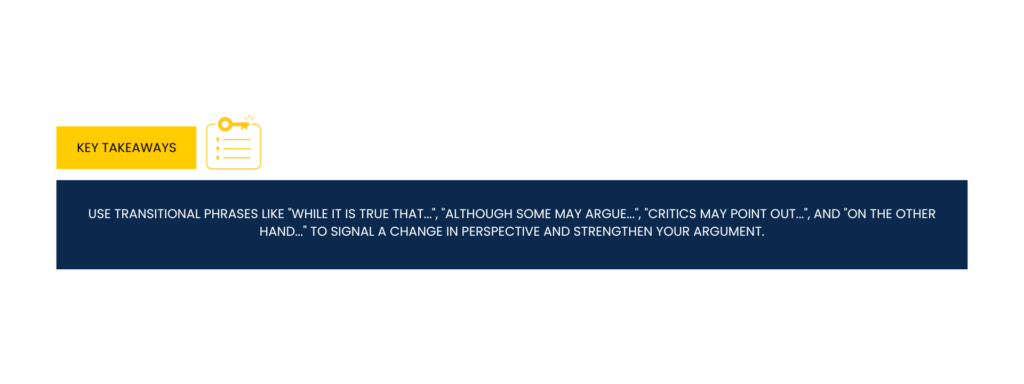Writing strong counterarguments is an important skill for effective writing that can take your work to a whole new level. Whether you’re a student, a debater, or a content marketer, being able to predict and respond to competing points of view can strengthen your cases. We’ll look at the heart of counterarguments and give you tips on how to learn this art in this in-depth guide.
Table of Contents
ToggleUnderstanding Counterarguments
Ineffective writing and counterarguments are very important because they do many important things. They show that the writer deeply understands the topic and how hard it is for them to understand. The writer shows strong critical thinking skills by addressing different points of view and possible arguments. This helps the argument by looking at it from various points of view and makes the writer seem more trustworthy. Convincingly responding to counterarguments shows that the writer has given the topic much thought, is open to different points of view, and wants to make a strong case. By recognizing the audience’s worries, this method makes the writing more convincing and creates a deeper link with them.
Recognizing the Other Person’s Point of View
Before you can make a strong counterargument, you need to carefully explain the other side’s view in a fair and polite way. This approach not only shows that you are neutral but also shows that you are ready to have a serious and fair conversation. By carefully showing the other side’s reasons, you show your audience that you have fully thought about their point of view. This makes your argument better and more powerful. Additionally, highlight the truth of the other side’s point of view by pointing out any good points or areas where you agree. This acknowledgment shows that you understand and connect, which makes your counterargument even stronger by showing that you have done a thorough analysis and value different points of view.
Crafting Compelling Counterarguments
After considering the other side’s point of view, it’s important to make your argument concise and easily understood. Carefully outline why your point of view is more convincing, focusing on the main points that set it apart from others. When you do this, try to be brief and direct, and make sure your counterargument is clear and easy for people to understand. This method improves your argument and shows that you know a lot about this topic. This will ensure that your points are clear and impact your audience for a long time. Learn how to use counterarguments in a sentences.
Supporting Your Counterargument
It is very important to support your counterargument with strong proof or examples that prove your point of view. Do not just express your opinion; carefully explain how each evidence supports your claim. This means making clear, reasonable links between the information you give and your claims. Details about how your evidence directly supports your claims should be included.
For example, you could use statistics, relevant studies, or past events that support your case. Using this evidence-based method makes your counterargument more convincing and makes your main point more credible. By firmly basing your counterargument on facts, you attract your audience more deeply and urge them to give your point of view the serious thought it deserves.
Addressing Potential Weaknesses
To strengthen your point of view, you need to think about what problems people may encounter if they disagree with you and be ready to answer them. This approach involves figuring out where your position might be weak and carefully planning how to respond. Not only will this show that you fully understand the problem, but it will also show that you are ready to accept helpful criticism.
To successfully answer these complaints, you should give well-thought-out replies establishing the opposition’s points. To do this, you need to challenge their beliefs or logic with clear, logical evidence to strengthen your case. By doing this much in-depth research, you not only improve your opinion but also make the argument stronger overall.
Positioning the Counterargument
Putting your counterargument in the right place in the structure of your paper isn’t just a matter of taste; it can have a big effect on how convincing and effective your argument is. Including the opposing view early on in your writing, after the opening but before the main points, helps give the reader a fair view immediately. This shows your readers that you have thought about different viewpoints, making you more credible. Instead, you could save the counterargument for the end after fully explaining your points of view. This way, you can end strongly by directly addressing and refuting the opposite views. This could have a big effect, making your situation even stronger.
You can find the most convincing and reasonable flow for your argument by putting your counterargument in different places, like the beginning, middle, or end. This will help you make sure it connects well with your audience.
Best Transition Words for Counterargument
To use counterarguments effectively and easily in your writing, you need to use transition sentences that make it clear when the point of view changes, going from your main argument to a different one. This method strengthens your arguments and shows you know a lot about this topic.
Here are some examples of transitional phrases that can help with this change:
- “While it is true that…” acknowledges a point’s validity before presenting a counter-view.
- “Although some may argue…” introduces opposition by acknowledging differing opinions.
- “Critics may point out…” allows you to anticipate and address specific objections to your arguments.
- “On the other hand…” contrasts a previously stated idea with an alternative perspective.
Using these phrases can significantly improve the flow and coherence of your writing, making your arguments more nuanced and persuasive.
Efficient Counterargument Crafting
To master the art of crafting compelling counterarguments swiftly, it’s advisable to employ several strategic techniques:
- Identify Common Objections: Consider the most likely things that could be said against your case first. Think about the arguments that people might bring up against what you say. By figuring out these issues early on, you can answer them in your argument, which will improve your position and show that you know a lot about the topic of discussion.
- Use a Template: Create a regular format or outline for your counterarguments. This can greatly speed up the writing process, making it easier and shorter to put together answers that are well-organized and make sense. A good example is an opening to the argument, your response, and a closing statement that supports your main point.
- Research Opposing Views: To successfully oppose an argument, you must first know what it is. Spend some time getting to know the most popular reasons against your topic. Read and join groups, debates, and talks to understand how big and deep the opposition is. This information will not only help you prepare for possible issues, but it will also help you answer them more effectively by showing you where they fall short and helping you make stronger counterarguments.
By implementing these techniques, you’ll be better equipped to quickly and efficiently dismantle opposing views, solidifying your argument and enhancing your persuasive power.
Counterargument Tips and Tricks
There are few tips and tricks which can help a lot in counterargument.
- Be Respectful: Always speak with respect and care when discussing different viewpoints. This method helps make a space where people can talk to each other and understand each other better. Accept that different points of view are acceptable and interact with them carefully.
- Stay Focused: Make sure your counterarguments are short, easy to understand, and directly related to the main topic. Avoid getting separate issues to discuss unrelated problems that could weaken your case. Staying focused ensures that the conversation stays useful and on topic, making it easier to dig deeper into the topic.
- Use Rhetorical Devices: To connect your audience better and make your counterarguments stronger, use rhetorical techniques in a planned way, like using strong examples or phrases that make people think.
Effective Counterarguments
| Technique | Description | Example | Benefits |
|---|---|---|---|
| Acknowledge Opposing Viewpoints | Recognize and address opposing viewpoints | "While some may argue that...", "Although it is true that..." | Builds credibility, shows understanding |
| Support with Evidence | Use evidence and examples to support counterarguments | "According to a recent study...", "For instance, in the case of..." | Makes argument more persuasive, credible |
| Address Potential Weaknesses | Identify and address potential weaknesses in your argument | "One potential criticism of this argument is...", "Some may argue that this point is weak because..." | Strengthens argument, shows awareness |
| Use Rhetorical Devices | Use rhetorical devices to make counterarguments more engaging | "On the other hand...", "In contrast,..." | Makes argument more engaging, memorable |
| Stay Respectful and Focused | Stay respectful and focused when presenting counterarguments | "I understand that some may disagree, but...", "Let's stay focused on the main issue..." | Builds trust, credibility, and constructive dialogue |
Conclusion
Writing and critical thinking both require the ability to make strong counterarguments. Understanding the value of counterarguments, recognizing different points of view, providing well-supported rebuttals, and smartly placing your counterarguments can greatly improve the persuasiveness of your writing. Avoid rudeness and stay on topic. To make your point more interesting and remembered, use literary techniques. You can predict and respond to competing views with confidence and conviction once you’ve practiced and mastered these techniques. This will make your points stronger and more believable.
FAQs
Q: What is the purpose of a counterargument in writing?
A: A counterargument acknowledges and addresses opposing viewpoints, making your argument more persuasive and credible.
Q: How do I identify potential counterarguments?
A: Consider the most likely objections to your argument and research opposing views to anticipate and address them effectively.
Q: How can I make my counterarguments more engaging and memorable?
A: Use rhetorical devices, such as strong examples and phrases that make people think, to connect with your audience and make your points more persuasive.
Q: What is the importance of staying respectful when presenting counterarguments?
A: Respectful language and tone help create a space for constructive dialogue and make your argument more credible and persuasive.











